高中英语语法(动名词)
- 格式:doc
- 大小:145.00 KB
- 文档页数:17
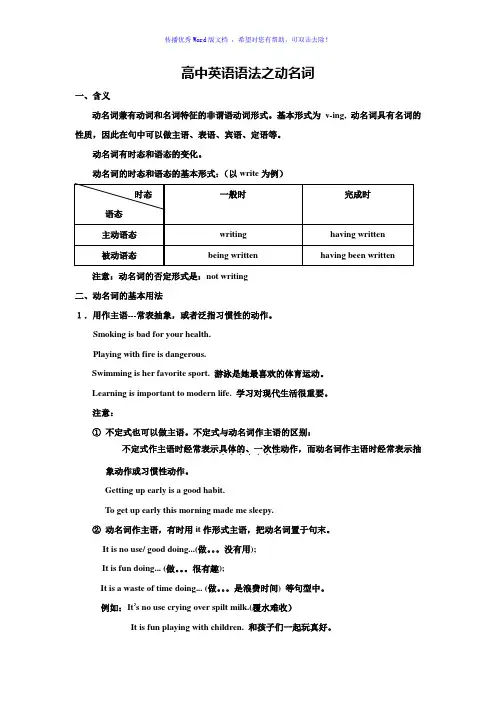
高中英语语法之动名词一、含义动名词兼有动词和名词特征的非谓语动词形式。
基本形式为v-ing, 动名词具有名词的性质,因此在句中可以做主语、表语、宾语、定语等。
动名词有时态和语态的变化。
动名词的时态和语态的基本形式:(以write为例)注意:动名词的否定形式是:not writing二、动名词的基本用法1.用作主语---常表抽象,或者泛指习惯性的动作。
Smoking is bad for your health.Playing with fire is dangerous.Swimming is her favorite sport. 游泳是她最喜欢的体育运动。
Learning is important to modern life. 学习对现代生活很重要。
注意:①不定式也可以做主语。
不定式与动名词作主语的区别:不定式作主语时经常表示具体的、一次性.......动作,而动名词作主语时经常表示抽象动作或习惯性动作。
Getting up early is a good habit.To get up early this morning made me sleepy.②动名词作主语,有时用it作形式主语,把动名词置于句末。
It is no use/ good doing...(做。
没有用);It is fun doing... (做。
很有趣);It is a waste of time doing... (做。
是浪费时间) 等句型中。
例如:It’s no use crying over spilt milk.(覆水难收)It is fun playing with children. 和孩子们一起玩真好。
It is a waste of time persuading such a person to join us.说服这样一个人加入我们当中来是浪费时间。
2. 作宾语①作某些及物动词的宾语常见的动词有:advise,avoid,delay,escape,excuse,enjoy,consider,finish,deny,fancy,keep,mind(在乎)postpone,pardon,practise,suggest,imagine等。
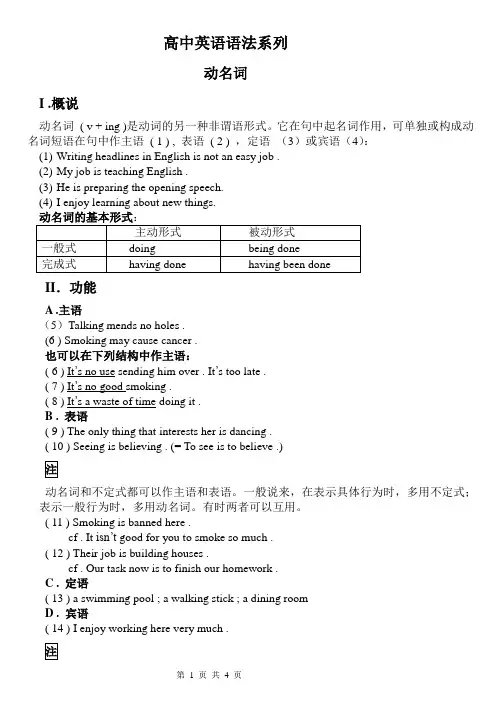
高中英语语法系列动名词I .概说动名词( v + ing )是动词的另一种非谓语形式。
它在句中起名词作用,可单独或构成动名词短语在句中作主语( 1 ) , 表语( 2 ) ,定语(3)或宾语(4):(1)Writing headlines in English is not an easy job .(2)My job is teaching English .(3)He is preparing the opening speech.(4)I enjoy learning about new things.II.功能A .主语(5)Talking mends no holes .(6 ) Smoking may cause cancer .也可以在下列结构中作主语:( 6 ) It’s no use sending him over . It’s too late .( 7 ) It’s no good smoking .( 8 ) It’s a waste of time doing it .B . 表语( 9 ) The only thing that interests her is dancing .( 10 ) Seeing is believing . (= To see is to believe .)动名词和不定式都可以作主语和表语。
一般说来,在表示具体行为时,多用不定式;表示一般行为时,多用动名词。
有时两者可以互用。
( 11 ) Smoking is banned here .cf . It isn’t good for you to smoke so much .( 12 ) Their job is building houses .cf . Our task now is to finish our homework .C . 定语( 13 ) a swimming pool ; a walking stick ; a dining roomD . 宾语( 14 ) I enjoy working here very much .下面动词只能接动名词作宾语:mind , miss , enjoy , escape , excuse , imagine , practise , postpone , suggest , consider , admit , avoid , advise , allow , require , finish 等。
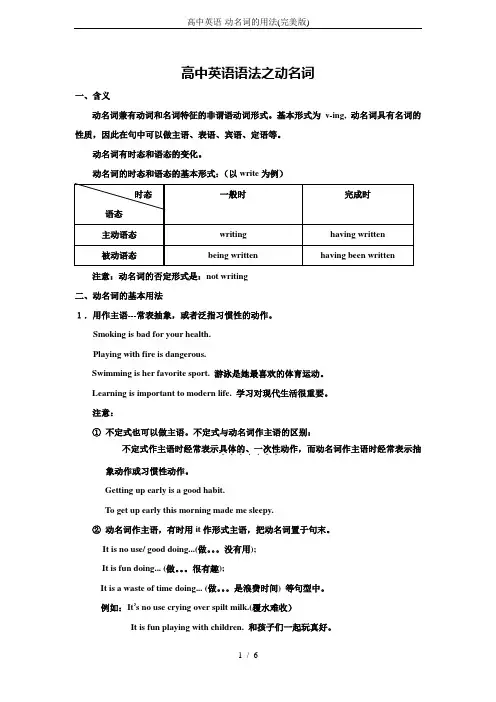
高中英语语法之动名词一、含义动名词兼有动词和名词特征的非谓语动词形式。
基本形式为v-ing, 动名词具有名词的性质,因此在句中可以做主语、表语、宾语、定语等。
动名词有时态和语态的变化。
动名词的时态和语态的基本形式:(以write为例)注意:动名词的否定形式是:not writing二、动名词的基本用法1.用作主语---常表抽象,或者泛指习惯性的动作。
Smoking is bad for your health.Playing with fire is dangerous.Swimming is her favorite sport. 游泳是她最喜欢的体育运动。
Learning is important to modern life. 学习对现代生活很重要。
注意:①不定式也可以做主语。
不定式与动名词作主语的区别:不定式作主语时经常表示具体的、一次性.......动作,而动名词作主语时经常表示抽象动作或习惯性动作。
Getting up early is a good habit.To get up early this morning made me sleepy.②动名词作主语,有时用it作形式主语,把动名词置于句末。
It is no use/ good doing...(做。
没有用);It is fun doing... (做。
很有趣);It is a waste of time doing... (做。
是浪费时间) 等句型中。
例如:It’s no use crying over spilt milk.(覆水难收)It is fun playing with children. 和孩子们一起玩真好。
It is a waste of time persuading such a person to join us.说服这样一个人加入我们当中来是浪费时间。
2. 作宾语①作某些及物动词的宾语常见的动词有:advise,avoid,delay,escape,excuse,enjoy,consider,finish,deny,fancy,keep,mind(在乎)postpone,pardon,practise,suggest,imagine等。
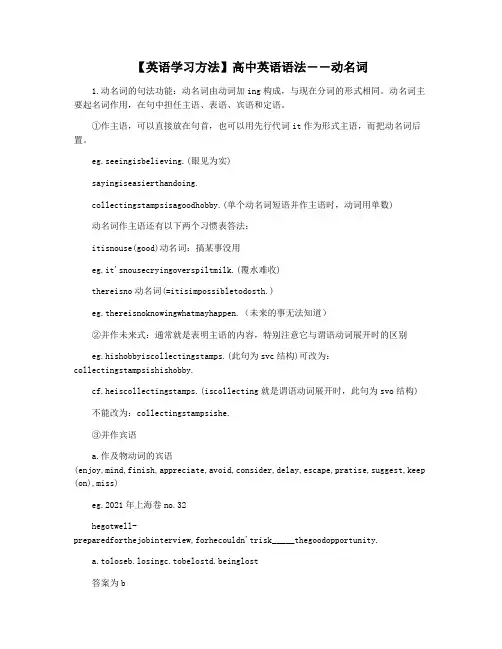
【英语学习方法】高中英语语法――动名词1.动名词的句法功能:动名词由动词加ing构成,与现在分词的形式相同。
动名词主要起名词作用,在句中担任主语、表语、宾语和定语。
①作主语,可以直接放在句首,也可以用先行代词it作为形式主语,而把动名词后置。
eg.seeingisbelieving.(眼见为实)sayingiseasierthandoing.collectingstampsisagoodhobby.(单个动名词短语并作主语时,动词用单数)动名词作主语还有以下两个习惯表答法:itisnouse(good)动名词:搞某事没用eg.it'snousecryingoverspiltmilk.(覆水难收)thereisno动名词(=itisimpossibletodosth.)eg.thereisnoknowingwhatmayhappen.(未来的事无法知道)②并作未来式:通常就是表明主语的内容,特别注意它与谓语动词展开时的区别eg.hishobbyiscollectingstamps.(此句为svc结构)可改为:collectingstampsishishobby.cf.heiscollectingstamps.(iscollecting就是谓语动词展开时,此句为svo结构)不能改为:collectingstampsishe.③并作宾语a.作及物动词的宾语(enjoy,mind,finish,appreciate,avoid,consider,delay,escape,pratise,suggest,keep (on),miss)eg.2021年上海卷no.32hegotwell-preparedforthejobinterview,forhecouldn'trisk_____thegoodopportunity.a.toloseb.losingc.tobelostd.beinglost答案为b有些动词(attempt,begin,continue,hate,like,love)后面既可以直奔不定式并作宾语,也可以直奔动名词并作宾语,意义差别并不大。
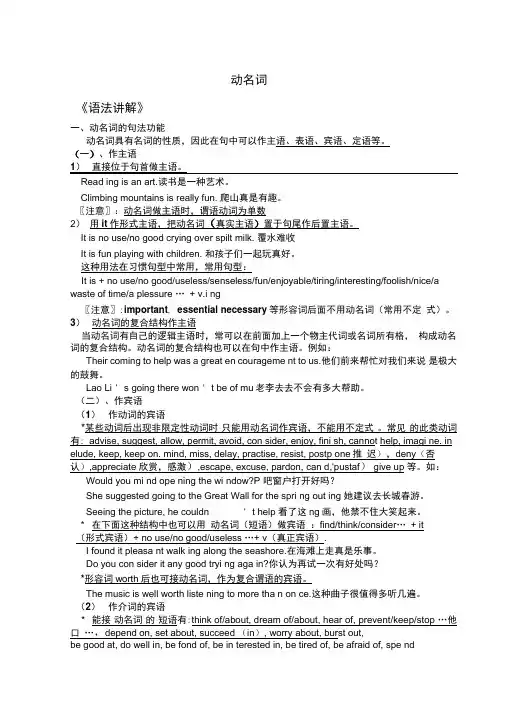
动名词《语法讲解》一、动名词的句法功能动名词具有名词的性质,因此在句中可以作主语、表语、宾语、定语等。
(一)、作主语1)直接位于句首做主语。
Read ing is an art.读书是一种艺术。
Climbing mountains is really fun. 爬山真是有趣。
〖注意〗:动名词做主语时,谓语动词为单数2)用it作形式主语,把动名词(真实主语)置于句尾作后置主语。
It is no use/no good crying over spilt milk. 覆水难收It is fun playing with children. 和孩子们一起玩真好。
这种用法在习惯句型中常用,常用句型:It is + no use/no good/useless/senseless/fun/enjoyable/tiring/interesting/foolish/nice/a waste of time/a plessure … + v.i ng〖注意〗:important, essential necessary等形容词后面不用动名词(常用不定式)。
3)动名词的复合结构作主语当动名词有自己的逻辑主语时,常可以在前面加上一个物主代词或名词所有格,构成动名词的复合结构。
动名词的复合结构也可以在句中作主语。
例如:Their coming to help was a great en courageme nt to us.他们前来帮忙对我们来说是极大的鼓舞。
Lao Li ' s going there won ' t be of mu老李去去不会有多大帮助。
(二)、作宾语(1)作动词的宾语*某些动词后出现非限定性动词时只能用动名词作宾语,不能用不定式。
常见的此类动词有: advise, suggest, allow, permit, avoid, con sider, enjoy, fini sh, cannot help, imagi ne. in elude, keep, keep on. mind, miss, delay, practise, resist, postp one推迟),deny(否认),appreciate 欣赏,感激),escape, excuse, pardon, can d,'pustaf) give up 等。
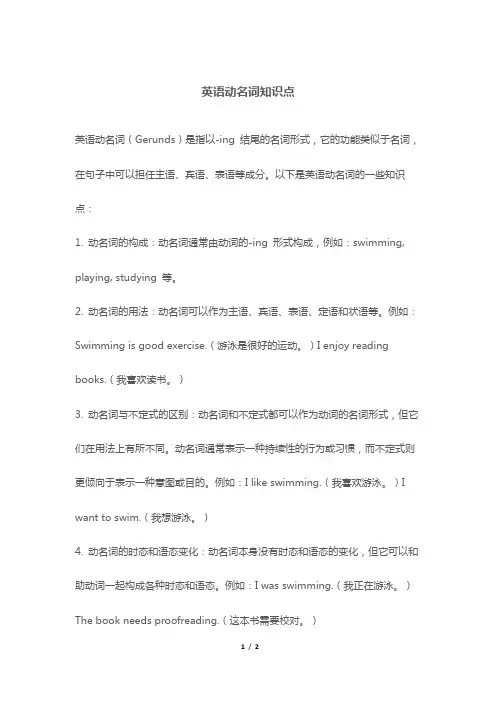
英语动名词知识点
英语动名词(Gerunds)是指以-ing 结尾的名词形式,它的功能类似于名词,在句子中可以担任主语、宾语、表语等成分。
以下是英语动名词的一些知识点:
1. 动名词的构成:动名词通常由动词的-ing 形式构成,例如:swimming, playing, studying 等。
2. 动名词的用法:动名词可以作为主语、宾语、表语、定语和状语等。
例如:Swimming is good exercise.(游泳是很好的运动。
)I enjoy reading books.(我喜欢读书。
)
3. 动名词与不定式的区别:动名词和不定式都可以作为动词的名词形式,但它们在用法上有所不同。
动名词通常表示一种持续性的行为或习惯,而不定式则更倾向于表示一种意图或目的。
例如:I like swimming.(我喜欢游泳。
)I want to swim.(我想游泳。
)
4. 动名词的时态和语态变化:动名词本身没有时态和语态的变化,但它可以和助动词一起构成各种时态和语态。
例如:I was swimming.(我正在游泳。
)The book needs proofreading.(这本书需要校对。
)
5. 动名词的常用搭配:动名词可以与不同的介词、动词、形容词等组合使用,构成不同的搭配,例如:interested in, good at, tired of 等。
以上是英语动名词的一些基本知识点,希望对您有所帮助。
如果您还有其他问题,欢迎继续向我提问。

动名词1 构成与特点动名词与现在分词同形,均由动词原形+ing构成。
动名词具有名词的特征,在句中可以作主语、宾语、表语和定语。
同时,动名词仍保留着动词的一些特征,可以带宾语和状语,并有完成式和被动语态。
1)动名词的否定式动名词的否定式由“not+动名词”构成。
He was criticized for not coming to class.他因没有来上课而受到批评。
She made her father angry by not taking his advice.她没有采纳她父亲的意见,使她父亲很生气。
He was scolded for not telling the truth.他因没说真话而挨了骂。
2)动名词的一般式动名词的一般式所表示的动作与谓语动词所表示的动作同时发生,或在谓语动词所表示的动作之后或之前发生,有时则表示一般性动作。
He loves talking with people.他喜欢跟人聊天。
(一般性)He is proud of being rich.他以富有为荣。
(同时)She is looking forward to seeing you again.她盼望着再次见到你。
(之后) I am confident of winning the match.我有信心赢得这场比赛。
(之后) Thank you for giving me so much help.谢谢你给我这么大的帮助。
(之前)3)动名词的完成式动名词的完成式表示的动作发生在谓语动词动作之前。
I'm not aware of having done wrong.我不知道自己做错了。
He denied having taken the money.他否认拿了钱。
He prided himself on having done good work.他以工作出色而感到自豪。
He was given a medal for having done excellent work.他因工作出色而获得了一枚奖章。
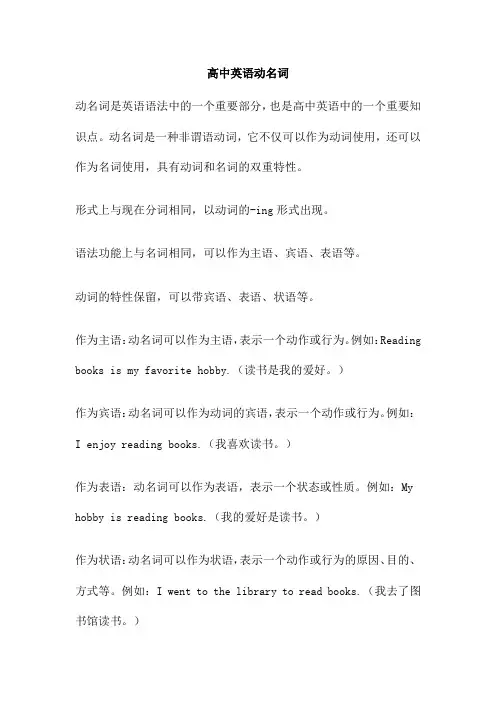
高中英语动名词动名词是英语语法中的一个重要部分,也是高中英语中的一个重要知识点。
动名词是一种非谓语动词,它不仅可以作为动词使用,还可以作为名词使用,具有动词和名词的双重特性。
形式上与现在分词相同,以动词的-ing形式出现。
语法功能上与名词相同,可以作为主语、宾语、表语等。
动词的特性保留,可以带宾语、表语、状语等。
作为主语:动名词可以作为主语,表示一个动作或行为。
例如:Reading books is my favorite hobby.(读书是我的爱好。
)作为宾语:动名词可以作为动词的宾语,表示一个动作或行为。
例如:I enjoy reading books.(我喜欢读书。
)作为表语:动名词可以作为表语,表示一个状态或性质。
例如:My hobby is reading books.(我的爱好是读书。
)作为状语:动名词可以作为状语,表示一个动作或行为的原因、目的、方式等。
例如:I went to the library to read books.(我去了图书馆读书。
)在高中英语中,动名词的使用非常普遍,尤其是在阅读、写作、听力等题型中。
因此,掌握好动名词的用法对于提高英语成绩非常重要。
在学习动名词时,需要注意以下几点:注意区分动词和动名词:动名词是以动词的形式出现,但它是名词的性质,因此需要注意区分动词和动名词,避免混淆。
注意动名词的语法功能:动名词具有名词的语法功能,可以作为主语、宾语、表语等,但是它也保留了动词的特性,可以带宾语、表语、状语等。
因此需要注意动名词的语法功能,正确使用。
注意动名词的时态和语态:动名词的时态和语态与动词相同,需要注意其变化规则和用法。
注意动名词的搭配:动名词可以与许多词搭配使用,如介词、副词、连词等,需要注意其搭配用法。
动名词是高中英语中的一个重要知识点,掌握好其用法对于提高英语成绩非常重要。
在学习动名词时,需要注意其形式、语法功能、时态和语态、搭配等方面的特点和使用规则,多加练习,不断提高自己的英语水平。
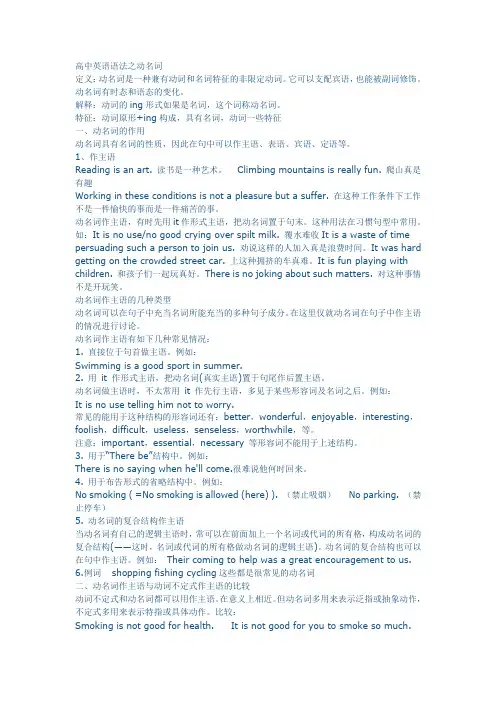
高中英语语法之动名词定义:动名词是一种兼有动词和名词特征的非限定动词。
它可以支配宾语,也能被副词修饰。
动名词有时态和语态的变化。
解释:动词的ing形式如果是名词,这个词称动名词。
特征:动词原形+ing构成,具有名词,动词一些特征一、动名词的作用动名词具有名词的性质,因此在句中可以作主语、表语、宾语、定语等。
1、作主语Reading is an art. 读书是一种艺术。
Climbing mountains is really fun. 爬山真是有趣Working in these conditions is not a pleasure but a suffer. 在这种工作条件下工作不是一件愉快的事而是一件痛苦的事。
动名词作主语,有时先用it作形式主语,把动名词置于句末。
这种用法在习惯句型中常用。
如:It is no use/no good crying over spilt milk. 覆水难收It is a waste of time persuading such a person to join us. 劝说这样的人加入真是浪费时间。
It was hard getting on the crowded street car. 上这种拥挤的车真难。
It is fun playing with children. 和孩子们一起玩真好。
There is no joking about such matters. 对这种事情不是开玩笑。
动名词作主语的几种类型动名词可以在句子中充当名词所能充当的多种句子成分。
在这里仅就动名词在句子中作主语的情况进行讨论。
动名词作主语有如下几种常见情况:1. 直接位于句首做主语。
例如:Swimming is a good sport in summer.2. 用it 作形式主语,把动名词(真实主语)置于句尾作后置主语。
动名词做主语时,不太常用it 作先行主语,多见于某些形容词及名词之后。
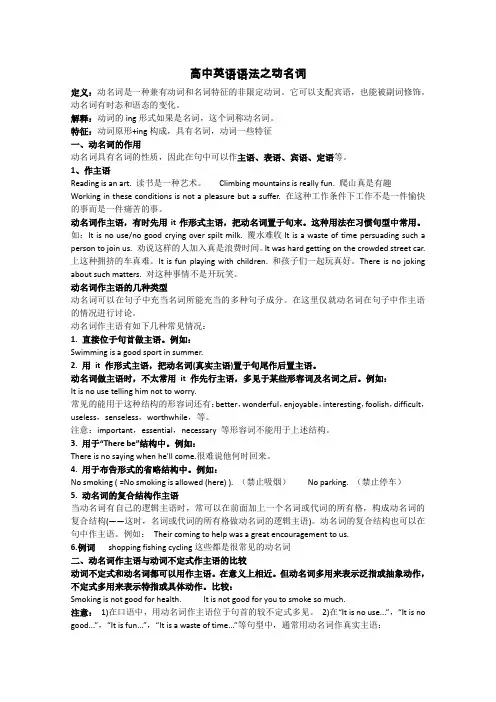
高中英语语法之动名词定义:动名词是一种兼有动词和名词特征的非限定动词。
它可以支配宾语,也能被副词修饰。
动名词有时态和语态的变化。
解释:动词的ing形式如果是名词,这个词称动名词。
特征:动词原形+ing构成,具有名词,动词一些特征一、动名词的作用动名词具有名词的性质,因此在句中可以作主语、表语、宾语、定语等。
1、作主语Reading is an art. 读书是一种艺术。
Climbing mountains is really fun. 爬山真是有趣Working in these conditions is not a pleasure but a suffer. 在这种工作条件下工作不是一件愉快的事而是一件痛苦的事。
动名词作主语,有时先用it作形式主语,把动名词置于句末。
这种用法在习惯句型中常用。
如:It is no use/no good crying over spilt milk. 覆水难收It is a waste of time persuading such a person to join us. 劝说这样的人加入真是浪费时间。
It was hard getting on the crowded street car. 上这种拥挤的车真难。
It is fun playing with children. 和孩子们一起玩真好。
There is no joking about such matters. 对这种事情不是开玩笑。
动名词作主语的几种类型动名词可以在句子中充当名词所能充当的多种句子成分。
在这里仅就动名词在句子中作主语的情况进行讨论。
动名词作主语有如下几种常见情况:1. 直接位于句首做主语。
例如:Swimming is a good sport in summer.2. 用it 作形式主语,把动名词(真实主语)置于句尾作后置主语。
动名词做主语时,不太常用it 作先行主语,多见于某些形容词及名词之后。

非谓语动词在高中英语中,非谓语动词包括动词不定式(to do)、动名词(-ing)、现在分词(-ing)与过去分词(-ed)三种形式,它们有不少共同特点:①在句子中不能充当谓语,不受主语人称和数的限制;②保留部分动词特性:可以后接宾语,可用副词修饰;③否定形式,都是在其前面加上not/never等否定词;④表示的动作,如果明显发生的谓语动词表示的动作之前(或者强调先后),要求用完成时态形式;⑤都不能作地点状语,只有动词不定式可以作目的状语;⑥没有主语,其表示动作的执行者叫作“逻辑性主语”(主动语态时),有时表示动作的承受者(被动语态时)非谓语动词可充当句子的很多成分,并且有时态和语态的变化如下:II动词ing形式的要点一. 动名词的时态和语态1.动名词的时态用法:1)一般式当动名词表示的动作正好与谓动同时发生或晚于谓动发生时,用一般式;e.g. ① He enjoys listening to music.② They are looking forward to visiting the science museum.2)完成式当动名词表示的动作明显早于谓动发生或强调动作的先后时,用完成式;e.g. ① She regretted having broken the law at that time.② They couldn`t remember having helped you with handwriting.2.动名词的被动语态用法:1)当动名词的逻辑性主语正好是其表示动作的承受者时,一般用被动;e.g. ① The president tried to avoid being questioned by the reporters.② The little boy remembered being given some sweets for his good deeds. ※为了避免太过累赘,常用一般被动式替代完成被动式;2)动名词的主动式表被动意义的用法:在want, need, require,(物作主语时) be worth, be busy等词后,常用动名词的主动形式表示被动意义;e.g. ① These desks want painting this afternoon.= These desks want to be painted this afternoon.② There are lot of places worth visiting in this city.3.逻辑性主语:动名词的逻辑性主语通常用(形容词性)物主代词或名词所有格来充当,但当其为无生命体、抽象名词或不定代词时,则常用普通格形式;e.g. ① Do you mind my smoking here?② I remember Lucy`s coming to Hangzhou for the first time.③ They are looking forward to the lesson coming to an end early.二.动名词的功能1. 动名词作主语:动名词作主语,强调一般普遍性或抽象性动作,而不定式强调个别或某次具体的动作!e.g. ① Reading aloud is important in learning a language.② Playing football is my favorite sport.※常有一些句型,动名词短语放在后面,仍然作真正的主语:1)句型一: It is + adj. /n. + doing其中it为形式主语,动名词短语才是真正的主语,适用的名词或形容词还有:no use/good, a waste of time, a pity, a good pleasure, time, useless, foolish, crazy, funny, interesting, worthwhile, nice, terrible, etc.e.g. ① It is no use crying over the spilt time.② It is great fun playing with the big big wolf.③It nice working with you.2)句型二:There is no + doing相当于句型:It is impossible to do sth……e.g. ① There is no joking on this matter.② There is no saying what may happen tomorrow.2. 动名词作宾语:1)主语+ 谓语+ doinge.g. ① When we got home, mum had finished cooking the supper yesterday.② Can you imagine floating on the sea for thirty days?※※要求只接动名词作宾语的动词还有:permit, admit, allow, forbid, ban, finish, complete, appreciate, avoid, bear, celebrate, delay, enjoy, escape, explain, include, keep, forgive, mention, practice, prevent, resist, suggest, postpone(推迟),consider(考虑), can`t help(禁不住), insist on, depend on, mean(打算), try(尝试) etc.2)句型结构:i). do+限定词(my, some, any, the等)+doing,表示“做……事”之意do some cleaning打扫卫生 do some shopping购物e.g. ① She likes doing some shopping on the weekend.ii). 用在worth, busy等形容词后面作宾语, 相当于固定搭配:e.g. ① This book is well worth reading.② The students are busy preparing for the final examination.iii). 主语 + have trouble/difficulty/a problem/a good time (in) doing 有困难/开心做…e.g. ① They had great difficulty finding the hotel.② He had a great time playing with the little dog.iv). 主语 + spend + time/money + doing 花时间或金钱做…e.g. ① They spent a lot of money collecting all the stamps.②The students always spend much time preparing for the final examination.v). 主语 + lose no time (in) + doing 立即做…e.g. ① They lost no time telling the teacher the good news.② The boy lost no time eating the nice delicious food as he was hungry too long.※在介词之后,通常用动名词作宾语,这是一个绝对概念;3)形式宾语用it作形式宾语,而真正的宾语则用动名词短语放在宾补之后;主语 + think/consider/find/feel like + it + useless/no use/no good + doinge.g. ① They found it useless explaining it to the big man.② The boy considered it no good arguing with his manager then.3 动名词作表语:动名词作表语, 表示对主语的解释说明, 可以和主语互换位置而整句意义不变;e.g. ① Her job is washing and cooking.② His favorite sport is playing basketball.4动名词作定语:动名词作定语, 表示被修饰词的功能用途, 使用范围等;e.g. ① This is a nice washing machine.② He has bought a new writing table.※动名词所修饰的名词(短语)不能充当其逻辑主语;。
动名词(doing) ==名词动名词顾名思义就是动词的名词形式。
或是名词化的”动词”.它既有动词的意思同时有具有名词的性质。
也就是说名词可以做的句子成分,动名词就可以(主语,宾语,表语,定语)。
Eg: I enjoy swimming. 【宾语】Swimming is fun. 【主语】This is a swimming pool.=a pool for swimming【定语】a swimming boy= a boy who is swimmingMy favourite sport is swimming.【表语】==Swimming is my favourite sport.【主语】动名词和现在分词在形式上只是拼写一样。
但在句中所起的作用却截然不同。
The film is exciting. 【分词】My favourite sport is swimming.【动名词】==Swimming is my favourite sport(“My favourite sport”=” swimming”)sleeping cars =cars for sleeping表目的sleeping boys=boys who are sleeping1. 做主语和表语:动名词做主语、表语通常表示一般、习惯性的或抽象的行为;不定式做主语、表语往往表示具体的或一次性的动作行为。
在有些结构时两者区别不大。
Eg: Swimming is fun.My job is teaching English.[例题]1). It’s necessary to be prepared for a job interview. ____ the answers ready will be of great help.A. To have hadB. Having hadC. HaveD. Having【D】2). The president would attend the meeting himself,_____ gave them a great deal of encouragement.A. The president would attendB. The president to attendC. The president attendedD. The president’s attending【D】3) How about the two of us ___ a walk down the garden?A. to takeB. takeC. takingD. will take【C】* 动名词的动作发出者如何表示?①Would you mind my/me opening the window?② I can’t imagine my best friend/my best friend’s laughing at my work.I suggest Tom/tom’s coming early.I suggest that he should come early.T he president’s attending the meeting himself gave them a great deal of encouragement.That the president attended the meeting himself gave them a great deal of encouragement.It is dangerous for children to swim alone.I open the door to come in.I open the door for them to come in.不定式的逻辑主语用for 引出It was a great deal of encouragement to them for the president to attend the meeting himself.2. 作宾语:常跟动名词做宾语的动词和短语有:avoid, understand, appreciate, enjoy, imagine, mind, admit, practise, suggest, consider(考虑), delay, keep, allow, permit, forbid, look forward to , can’t help(情不自禁),be/get /become used to(习惯于) , devote… to , lead to[例题]4). It is difficult to imagine his ___ the decision without any consideration.A. acceptB. acceptingC. to acceptD. accepted【B】5). I can’t stand ___ with Jane in the same office. She just refuses ___ talking while she works.A.working; stoppingB. to work; stoppingC. working; to stopD. to work; to stop【C】动名词常见考点:①动名词的实质就是名词化的动词。
高中英语语法之动名词定义:动名词是一种兼有动词和名词特征的非限定动词。
它可以支配宾语,也能被副词修饰。
动名词有时态和语态的变化。
解释:动词的ing形式如果是名词,这个词称动名词。
特征:动词原形+ing构成,具有名词,动词一些特征一、动名词的作用动名词具有名词的性质,因此在句中可以作主语、表语、宾语、定语等。
1、作主语Reading is an art. 读书是一种艺术。
Climbing mountains is really fun. 爬山真是有趣Working in these conditions is not a pleasure but a suffer. 在这种工作条件下工作不是一件愉快的事而是一件痛苦的事。
动名词作主语,有时先用it作形式主语,把动名词置于句末。
这种用法在习惯句型中常用。
如:It is no use/no good crying over spilt milk. 覆水难收It is a waste of time persuading such a person to join us. 劝说这样的人加入真是浪费时间。
It was hard getting on the crowded street car. 上这种拥挤的车真难。
It is fun playing with children. 和孩子们一起玩真好。
There is no joking about such matters. 对这种事情不是开玩笑。
动名词作主语的几种类型动名词可以在句子中充当名词所能充当的多种句子成分。
在这里仅就动名词在句子中作主语的情况进行讨论。
动名词作主语有如下几种常见情况:1. 直接位于句首做主语。
例如:Swimming is a good sport in summer.2. 用it 作形式主语,把动名词(真实主语)置于句尾作后置主语。
动名词做主语时,不太常用it 作先行主语,多见于某些形容词及名词之后。
高中英语语法动名词一. 概念动名词由动词原形+ING构成,是一种非谓语动词形式二. 相关知识点精讲:1.作主语。
例如:Fighting broke out between the South and the North. 南方与北方开战了。
2.作宾语a. 有些动词可以用动名词作宾语。
例如:admit 承认appreciate 感激avoid 避免complete完成consider认为delay 耽误deny 否认detest 讨厌endure 忍受enjoy 喜欢escape 逃脱fancy 想象finish 完成imagine 想象mind 介意miss 想念postpone推迟practice 训练recall 回忆resent 讨厌resume 继续resist 抵抗risk 冒险suggest 建议face 面对include 包括stand 忍受understand 理解forgive 宽恕keep 继续例如:Would you mind turning down your radio a little, please? 你把收音机音量调小一点,好吗The squirrel was lucky that it just missed being caught. 这松鼠幸运得很,刚逃避了被逮住的厄运。
b. 有些结构后面可以用动名词作宾语或其他成分。
例如:admit to prefer,to be used to lead to devoteoneself toobject to stick to no good no use be fond of look forwardtobe proud ofstick to no good no use be fond of look forwardtobe proud of be busy can't help be tired of be capableofbe afraid of think ofburst out keep on insist on count on set aboutput off be good at take up give up be successfulin3.作表语,对主语说明、解释。
高中语法复习——非谓语动词•英语中,不作句子的谓语,而是用于担任其它语法功能的v ,叫非谓语动词,它不受主语人称、数等因素的限定,又被称作非限定动词。
•三大非谓语动词:动名词,分词和不定式。
动名词的语法功能•作主语•Seeing is believing.•Listening to music is one of my hobbies.•Studying abroad has many advantages.•Getting to know the world is what the future society requires of us.习惯用法• A. It is no use / good/harm+Ving.It is no use quarreling with her.It’s no use crying over the spilt milk.• B. There is no+Ving.There is no denying (the fact) that women are playing an important role in the world today.There is no joking about this matter. 这事开不得玩笑。
作表语•作表语•My favorite pastime is collecting stamps.•Her hobby is swimming and cycling.•One of the good virtues of a young person is being punctual.•My job is teaching.•One of the most difficult tasks you may encounter is learning a foreign language.作动词宾语•作动词宾语•She enjoys listening to rock music.•We appreciate your offering to help.•We must avoid making such mistakes again.•People who like travelling have their reasons.跟动名词作宾语的v.及v. phrase•常见的能跟动名词作宾语的v.及v. phrase:•admit, appreciate, avoid, confess to, consider, delay, deny, endure(忍耐), enjoy,escape, excuse, fancy(想象), finish, forbid, imagine, mind, miss, permit, postpone, practice, risk, can't help, feel like, give up, keep out, object to (反对), oppose, put off(推迟).•注意:动名词作宾语后面带有补语,一般不用形式宾语it。
高中英语语法之动名词一、含义动名词兼有动词和名词特征的非谓语动词形式。
基本形式为v-ing,动名词具有名词的性质,因此在句中可以做主语、表语、宾语、定语等。
动名词有时态和语态的变化。
动名词的时态和语态的基本形式:(以write为例)注意:动名词的否定形式是:not writing二、动名词的基本用法1.用作主语…常表抽彖,或者泛指习惯性的动作。
Smoking is bad for your health・Playing with fire is dangerous・Swimming is her favorite sport.游泳是她最喜欢的体育运动。
Learning is important to modern life.学习对现代生活很重要。
注意:①不定式也可以做主语。
不定式与动名词作主语的区别:不定式作主语时经常表示具体的.一次性动作,而动名词作主语时经常表示抽象动作或习惯性动作。
Getting up early is a good habit.To get up early this morning made me sleepy.②动名词作主语,有时用it作形式主语,把动名词置于句末。
It is no use/ good doing...(做。
没有用);It is fun doing...(做… 很有趣);It is a waste of time doing...(做… 是浪费时间)等句型中。
例如:Ws no use crying over spilt milk.(覆水难收)It is fun playing with children.和孩子们一起玩真好。
1/71/71语法其实只是一些约定俗成的规则,多看几逅,记住就可以。
就这么简单!It is a waste of time persuading such a person to join us.说服这样一个人加入我们当中来是浪费时间。